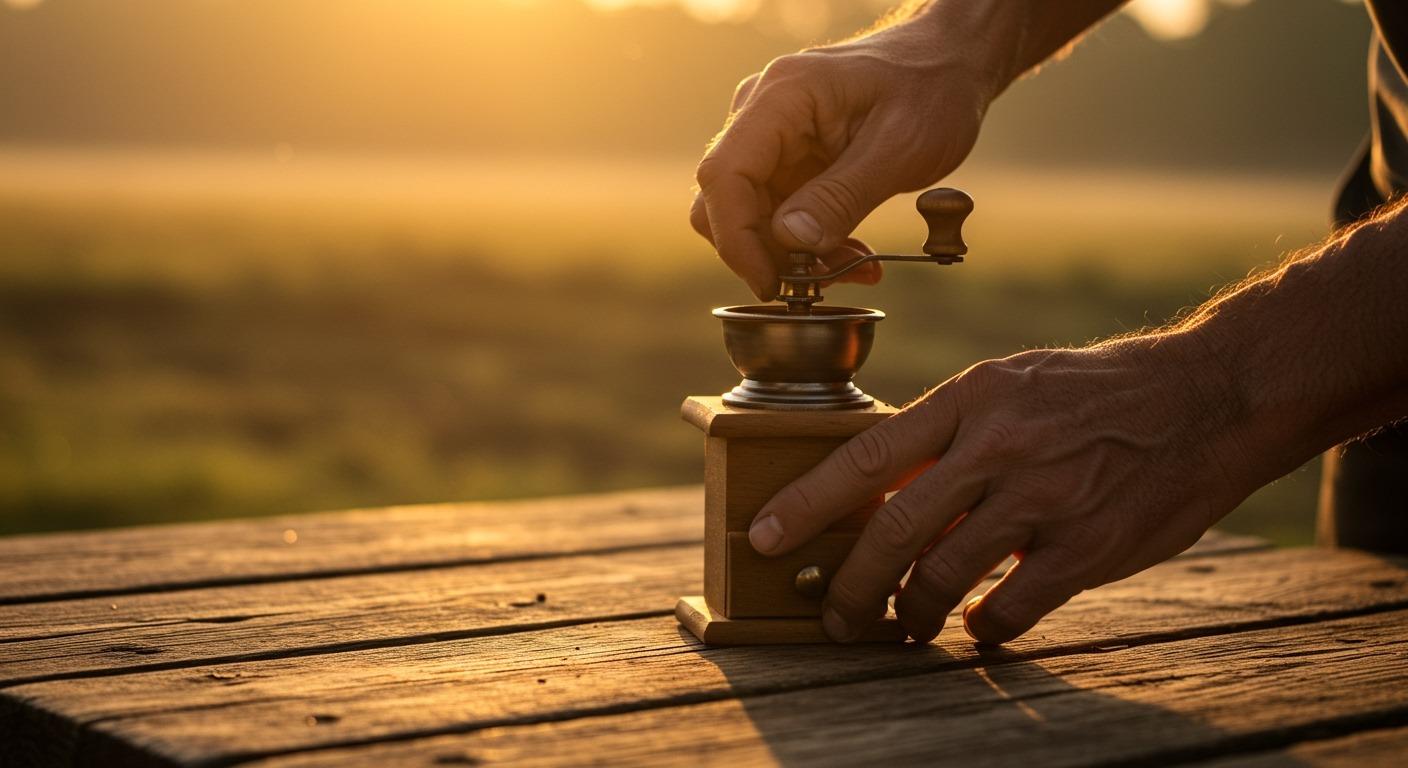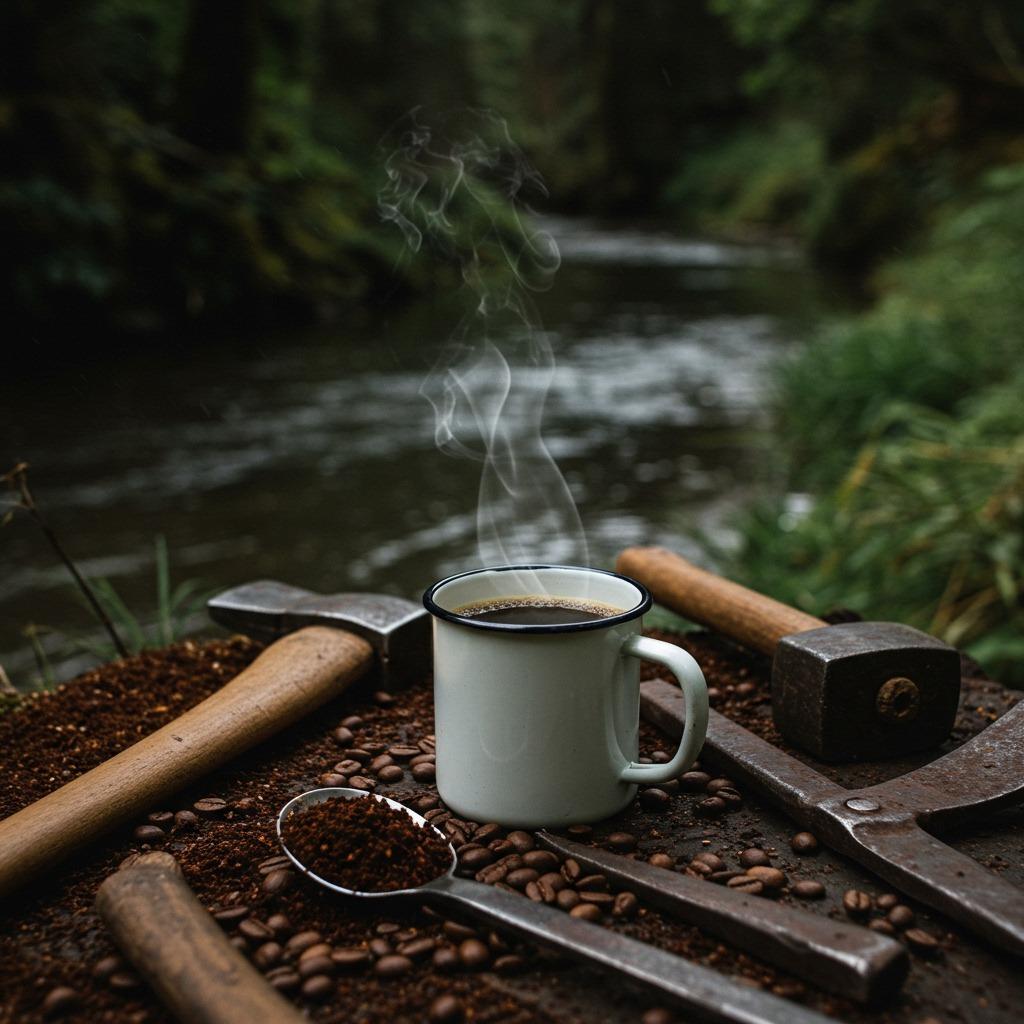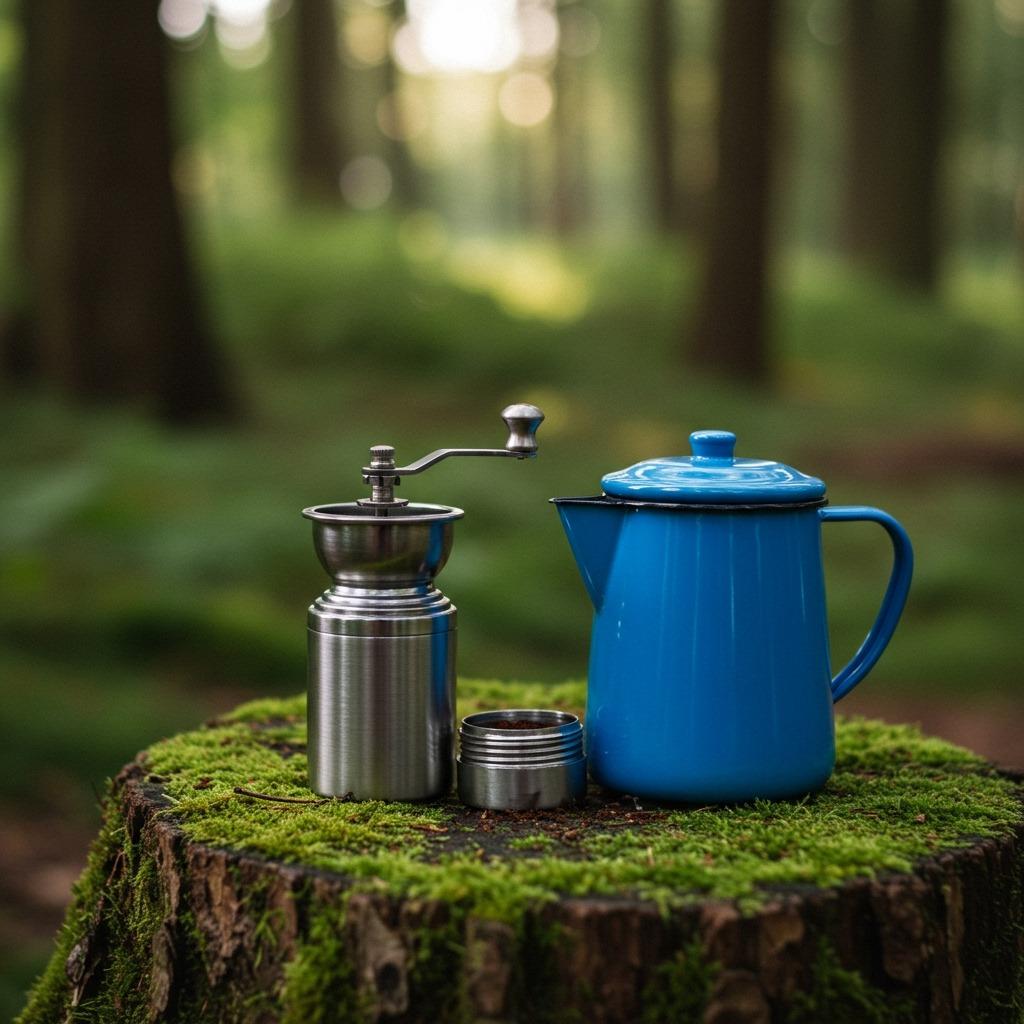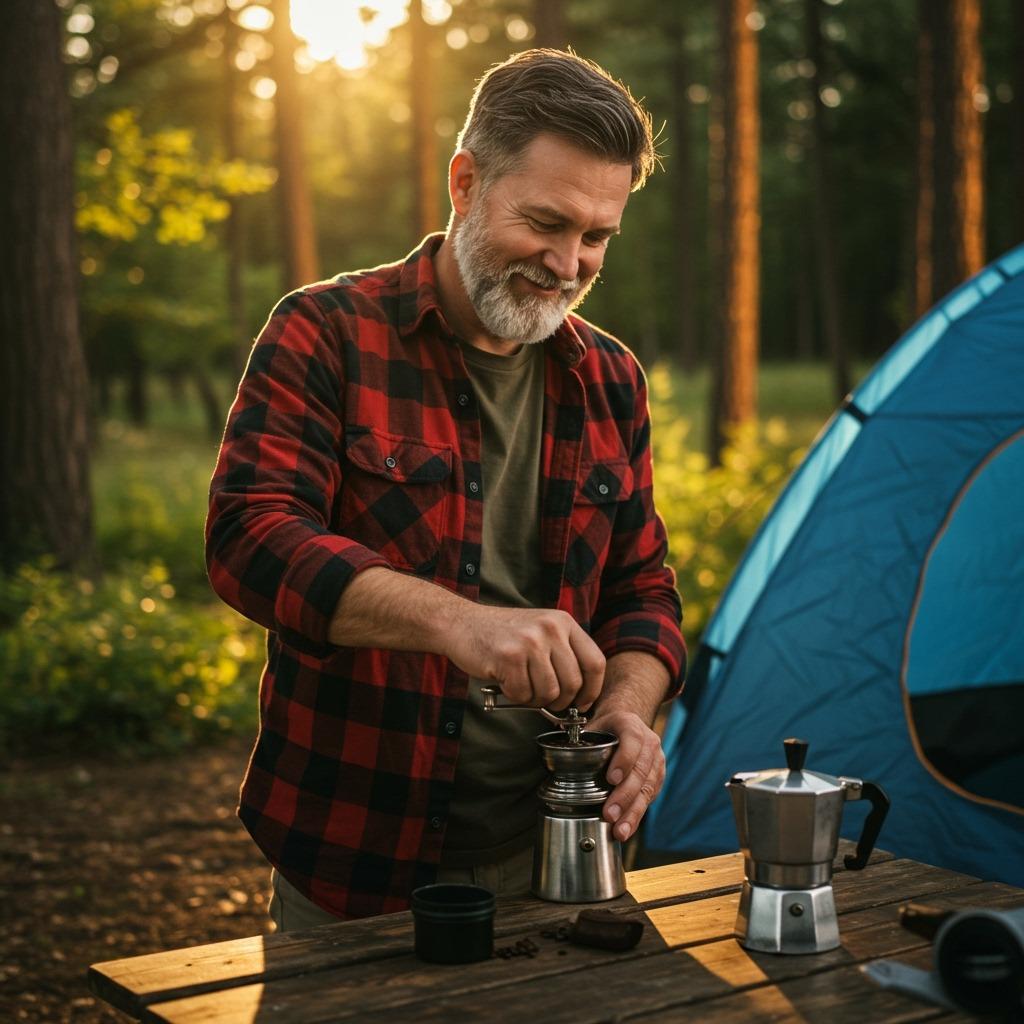Ever woken up at sunrise in your tent, shivering a little, excited for that first deep mug of camp coffee—only to find your beans are whole and you left the grinder at home? Been there, faced the groggy panic, and found a few hacks in the wild. Grinding coffee beans isn’t just barista science—it’s a ritual for starting the day right, whether on the trail, at the cabin, or prepping for a cozy morning at home.
Before diving in: Real hikers know the right gear matters. If you’re planning an extended trip, consider packing smart with this hiking checklist for a smooth start to every adventure.
The Day I Forgot My Grinder (and What I Learned)
Picture this: Early light filters through the pines, my old enamel kettle sputters, and everyone’s waiting for coffee. All I’ve got is a bag of whole beans. No grinder. Not even a rock that looks right.
That mistake taught me more in ten minutes than hours of YouTube tutorials—and gave me a deeper appreciation for fresh, DIY coffee. The truth? You can grind beans almost anywhere if you know what to use, and the method truly affects flavor.
Why Freshly Ground Coffee Matters
The secret behind that unforgettable campsite brew? Freshly ground beans. Once ground, coffee starts losing its flavor and aroma within minutes. Whether you’re making cowboy coffee over a campfire or brewing at home, fresh grounds equal better taste every time.
Understanding Grind Size: Why It’s Not One-Size-Fits-All
Coffee grind size isn’t just coffee snobbery—it changes everything. If your coffee tastes weak, sour, or bitter on the trail, the grind is usually to blame.
- Coarse grind: Feels gritty, like sea salt. Ideal for French press or cowboy coffee by the fire.
- Medium grind: Like sand. Best for drip coffee makers or pour-over setups.
- Fine grind: Feels like sugar or flour. Necessary for espresso or Moka pots.
- Extra fine: Almost powdery, for Turkish coffee.
If you love easy roadside breakfasts on your trips, check out my favorite camping breakfast ideas for pairing with the perfect mug.
The Best Tools For Grinding Coffee Beans Anywhere
You don’t need a $200 burr grinder to get good coffee. Here’s how seasoned outdoor folks handle grinding, with or without fancy gear.
Burr Grinder
Ask any coffee geek—burr grinders rule for consistency. They create even grounds, leading to smoother, balanced coffee. Some folks pack a manual burr grinder in their overnight kit. The trade-off? Heavier, but so worth it for taste and control.
Blade Grinder
If speed and budget matter more than perfection, a compact blade grinder will do. It chops instead of crushes, so the grind can be uneven. Still, it’s lightweight and plugs into most car inverters.
Manual Coffee Grinders
Hand-crank grinders pack easily, take no electricity, and give you the meditative satisfaction of prepping coffee by hand. A good one will last years and make incredible grounds, even at high elevation campsites.
No Grinder? No Problem
When all else fails, creativity becomes your best tool:
- Mortar and Pestle: Channel your inner pioneer.
- Heavy pan or rock: Wrap beans in a cloth and smash them gently (careful not to create dust, unless you’re aiming for Turkish coffee).
- Rolling pin or water bottle: Place beans in a strong zip bag and roll/crush away.
- Blender: In a cabin or van with power, pulse just a few times for coarse grounds.
Tip: Always try to grind just before brewing, and grind only what you need. Exposed grounds lose their rich flavor fast.

Matching Your Grind to Brew Method
Think of grind size like tent selection—it must match the conditions. Here’s how to dial in your grind for various outdoor brew styles:
Cowboy Coffee
Uses a coarse grind. Add grounds directly to hot water, let steep, then pour gently or skim grounds before sipping. No filter needed, just patience and a steady hand.
French Press
Coarse grind again. Too fine, and you’ll get mud in your mug. Let the grounds steep for 4-5 minutes, press slowly, and savor that bold flavor.
Pour Over
Medium to medium-fine grind. The water needs time to “hug” the grounds but not flood straight through. Pour in slow circles for even flavor extraction.
Aeropress
Medium-fine, depending on how long you steep. Great for backpackers—lightweight and nearly unbreakable.
Moka Pot & Espresso
Fine grind brings out espresso’s signature intensity. Too coarse, and you’ll get watery coffee; too fine, and you might clog the pot.
Turkish Coffee
Requires extra-fine, almost powdery, grind. Usually done with a special brass or steel grinder.
Night before you hike? Always prep your grounds and your hiking snacks for efficiency in the morning.
Grind Consistency: The Secret to Better-Tasting Coffee
Uniform grounds = even extraction. Regardless of method, avoid a mix of dust and pebbles. Why? Big pieces under-extract (sour), small ones over-extract (bitter). That’s why burr grinders—or careful, repeated crushing using a pan or bottle—are game-changers outdoors.
According to the Specialty Coffee Association, consistency in grind size is one of the most critical factors in brewing exceptional coffee, whether at home or in the backcountry.
Grinding Coffee Beans Without a Grinder: Field-Tested Hacks
Gone off-grid without your grinder? It happens more than you’d think. Here’s what works in the wild:
- Mortar and Pestle: Crush in small batches, using slow, circular movements.
- Cast-Iron Pan or Rock: Fold beans in a clean bandana or towel, strike firmly, then roll.
- Knife Blade: Place beans on a cutting board, press with the flat side, and roll (like crushing garlic).
- Portable Blender: Some vanlifers use USB-rechargeable blenders for a quick pulse.
Not sure? Test the grind with your fingers and adjust as needed. When in doubt, err on the coarse side—it’s easier to steep longer than fix bitterness!

Keeping Your Grinder Clean (Even Outdoors)
Even the best grinder gets gunky fast. Oils from beans and fine powder clump up, especially in humid or rainy camp conditions. After your trip:
- Unplug and brush out loose grounds.
- For manual grinders, disassemble and wipe each part with a damp cloth.
- Once a month (or after a few trips), grind a handful of uncooked rice to clear stubborn oils.
Grind care is as vital as tent care—clean gear means better-tasting coffee and fewer backpack surprises.
Gear Spotlight: Favorite Portable Grinders & Tools
Here are some tested favorites:
1. Hario Skerton Pro
- Affordable, durable manual burr grinder
- Fits in most camp kitchen kits
2. Porlex Mini - Super compact, stainless steel, easy to clean
3. JavaPresse Manual Grinder - Adjustable settings, smooth turning handle
4. GSI Outdoors Java Mill - Made for rough use, collapses for storage.
5. Timemore Chestnut Nano - High-end, sleek, and ultralight for true coffee aficionados
For campers improvising, a cast-iron skillet or even a sturdy water bottle can double as a grinder in a pinch.

Trail Hazards: Common Grinding Mistakes (And How To Fix Them)
Nobody wants bad camp coffee, but these errors happen:
- Grinding too much at once: Fresh grounds fade fast, especially in humid zones.
- Wrong grind size for brew: Coarse in a Moka pot = weak, fine in a French press = gritty.
- Dirty gear: Old oils ruin new brews.
- Impatience: Crushing is slower than you think; take your time for even, tasty results.
If you’re new to camping, this camping for beginners guide will help with other prep essentials, making sure that morning coffee is never your only challenge.
Pro Tips to Elevate Your Grind (Home or Trail)
Want to taste the difference? Try these:
- Weigh beans before grinding: Consistency means tastier coffee.
- Experiment with water: Hard/soft water changes the extraction. Test at home and on the trail.
- Refine by taste: Adjust grind size from “sour” (too coarse) or “bitter” (too fine).
- Store beans airtight: Humidity is the enemy.
Want to geek out more? Check out guides from Serious Eats for deeper science on coffee extraction and brewing techniques.

Beyond the Grind: Making the Most of Your Outdoor Coffee Ritual
There’s something deeply meditative about grinding beans as the sun comes up, birds chirping, steam swirling up from your mug. Whether you’re in the backcountry, road tripping, or just brewing on your porch, the right grind turns “just coffee” into adventure fuel.
For those chilly mornings when that warm cup feels extra essential, don’t miss our guide on how to stay warm while camping for complete comfort strategies.
For more gear, strategies, and camp kitchen tips, REI’s Expert Advice offers trusted field-tested wisdom from seasoned outdoor enthusiasts.
Frequently Asked Questions: Grinding Coffee Beans
Q1: What’s the best way to grind coffee beans without a grinder?
If you’re outdoors or at home with no grinder, use a mortar and pestle, a heavy skillet, or even a sturdy water bottle. Place beans in a sealed bag, then crush/roll until you reach the desired consistency. It may take patience, but it works!
Q2: How fine should I grind coffee for different brewing styles?
Coarse for French press/cowboy coffee, medium for drip/pour-over, and fine for espresso or Moka pot. Too fine leads to bitter, muddy coffee; too coarse tastes weak or sour.
Q3: Does grind size really affect taste that much?
Yes! Grind size determines how quickly water extracts flavor from the beans, so matching grind with brewing method is key for balanced, delicious coffee.
Q4: Can I pre-grind beans at home for camping?
Yes, but grind just enough for each day and store grounds in a sealed, airtight bag. Freshness fades fast, especially in humid or hot camp conditions.
Q5: How do I clean my grinder when camping?
Pack a small brush for regular wipes, and if it’s a manual grinder, disassemble and rinse with water. Let dry fully before storing. A few grains of rice can help clear oily residue in a pinch.
